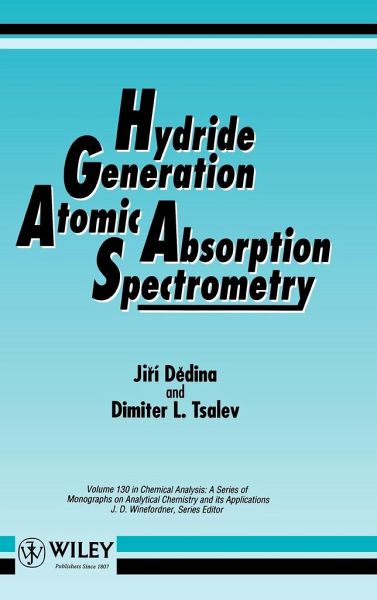
Hydride Generation Atomic Absorption Spectrometry
Versandkostenfrei!
Versandfertig in über 4 Wochen
793,99 €
inkl. MwSt.

PAYBACK Punkte
397 °P sammeln!
Antimony, arsenic, bismuth, germanium, lead, selenium, tellurium and tin ? just some of the elements which, in trace amounts, have biological, environmental and technological importance. Hydride Generation Atomic Absorption Spectrometry describes one of the most accurate analytical techniques for trace analysis of these elements, sensitive to picogram levels. Over the last decade, significant instrumental and methodological progress has led to HG-AAS being widely applied to an extensive range of sample types. In this first comprehensive monograph on HG-AAS, the authors treat both theoretical a...
Antimony, arsenic, bismuth, germanium, lead, selenium, tellurium and tin ? just some of the elements which, in trace amounts, have biological, environmental and technological importance. Hydride Generation Atomic Absorption Spectrometry describes one of the most accurate analytical techniques for trace analysis of these elements, sensitive to picogram levels. Over the last decade, significant instrumental and methodological progress has led to HG-AAS being widely applied to an extensive range of sample types. In this first comprehensive monograph on HG-AAS, the authors treat both theoretical and experimental aspects of the subject in a critical and in-depth manner. Hydride Generation Atomic Absorption Spectrometry is divided into two parts, with the theoretical background and experimental approach covered in Part I. Part II discusses the methodology and analytical applications to a wide range of fields, arranged in an easy to use element-by-element format. Over 1500 references provide an exhaustive coverage of the vast literature on HG-AAS, making Hydride Generation Atomic Absorption Spectrometry the premier reference source on this important technique. Hydride Generation Atomic Absorption Spectrometry will be an invaluable reference work for all analysts using hydride generation for AAS or for other spectrometric methods. It will also be of great interest to researchers and students working in atomic spectrometry and trace analysis.


